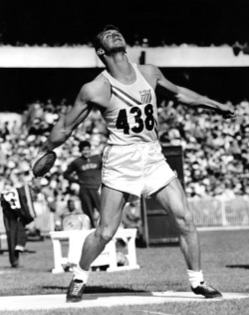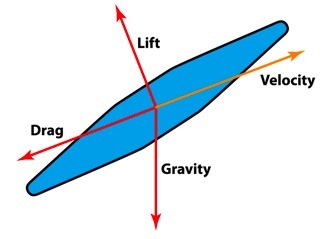Throwing for gold into a stiff headwind
By Burkard Polster and Marty Ross
The Age, 18 August 2008

Al Oerter, the legendary Olympian, passed away last year at the age of 71. Beginning with the 1956 Games in Melbourne, he won four consecutive gold medals for the discus throw, each time setting a new Olympic record.
At his third Games, Oerter was plagued by a back injury and torn rib cartilage. Adding insult to extensive injury, as Oerter prepared for his penultimate throw a headwind sprang up. He gritted his teeth and launched his discus into the headwind, setting a personal best and a new Olympic record of 212 feet and 6 inches (64.77 meters).
A miracle? Maybe. But the headwind probably helped! Unlike other athletics events, a headwind can in fact be an advantage to a discus thrower --- a 30 km/h headwind can add at least 5 meters to a throw. The calculations are messy, but there is a simple underlying principle.
A discus in flight must fight the gravitational pull of the Earth and the drag from air resistance. The discus’s wedge-shape ensures the drag is not large, but of course it will be larger into a headwind. However, if the discus is actually tilted relative to its flight then it will not slice so cleanly through the air: the drag will be larger, but the air resistance will also be pushing from underneath giving a vertical lifting force to the discus. This means the discus will be in the air for longer.

There is then a trade-off: a reasonable headwind increases the discus’s flight time sufficiently to outweigh the extra drag. However, throwing into a hurricane won’t work: your discus will be aloft for a long time, but it will be going straight up, or backwards. The optimal headwind is a matter of messy calculation, and trial and error. It seems that between 30 km/h and 40 km/h is best.
We can ask the same question for the other throwing events. Not surprisingly, the shot put and the hammer throw are too heavy for wind to “lift” the shot to any meaningful extent. The javelin is trickier, and javelin thrower and engineer Les Hatton has looked carefully at this question. Les’s belief is that a superhuman may be able to throw a javelin further into a headwind, but that this could not happen in the real world conditions of a sports competition.
So, we have some understanding of the headwind phenomenon, even if the detailed calculations are beyond us. However, there is another discus puzzler that we cannot even begin to explain. Though the effect of headwind on the discus throw is much greater than the effect of tailwind on the 100 meters sprint, there is no similar wind-assistance rule disqualifying records such as Oerter’s. Probably unfair, but for Oerter’s sake, we’re delighted.
Copyright 2004-∞ ![]() All rights reserved.
All rights reserved.